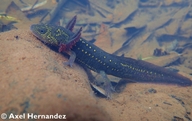|
Ambystoma ordinarium Taylor, 1940
Michoacan Stream Salamander, Puerto Hondo Stream Salamander Subgenus: Heterotriton | family: Ambystomatidae genus: Ambystoma |
| Species Description: Taylor, E. H. (1940 "1939"). New salamanders from Mexico, with a discussion of certain known forms. University of Kansas Science Bulletin 26: 407–430. | |
 © 2018 Axel Hernandez (1 of 13) |
|
|
|
Description Distribution and Habitat Country distribution from AmphibiaWeb's database: Mexico
Life History, Abundance, Activity, and Special Behaviors Neoteny is prevalent in this polymorphic species, but not uniform within populations. Metamorphic adults are terrestrial and have been observed to occupy the high-elevation woods and streamside habitats alongside juveniles. Paedomorphic adults and larvae are found in the montane streams (Anderson and Worthington 1971). An average of 109 eggs are laid singly or in clusters of 2-5 eggs onto the undersurfaces of roots, branches, and rocks, hanging free in the current. Eggs are pigmented and measure 9.9 mm including all layers of egg capsules. Each egg is encased in two inner capsules plus a third, thicker outer capsule. Egg clusters are observed not within an envelope, but consisting of individual eggs stuck together (Anderson and Worthington 1971). Ambystoma ordinarium appears to have a prolonged breeding season which may extend throughout the entire year, unusual for a temperate salamander. In the wild, eggs, embryos of various stages and larvae of different sizes have been found in both July and January. The testis and cloacal glands of males undergo no periodic changes once mature, suggesting the capability to reproduce year-round. Periodic changes do occur in females, but reproductive cycles are asynchronous within a population, evidence also of the species’ ability to breed throughout the year. Opportunistic breeders are able to continuously add small numbers of larvae to colonies throughout the year. Since environmental conditions are fairly consistent year-round, the staggered breeding may serve to reduce intraspecific competition for resources in the small mountain streams (Anderson and Worthington 1971). Stream-breeding is unusual among ambystomatid salamanders, as most of these species breed in ponds. Only two Ambystoma species, Ambystoma rosaceum and Ambystoma ordinarium, breed in moving water in a natural setting. It is thought that Ambystoma ordinarium has invaded stream habitats relatively recently, in evolutionary time. As would be expected for stream-dwelling salamanders, older larvae and neotenic adults show reduced fins, possess no balancers, develop limbs and digits early, and have a reduced gill size. However, new hatchlings have fully developed fins and well-developed ypsiloid cartilage, as is typical of pond-breeding salamanders. The hatchlings of Ambystoma ordinarium are thus more mature than those of typical pond breeders, but less mature than those of stream breeders. Adults and larvae alike walk on the bottom more than they swim (Anderson and Worthington 1971). Ambystoma ordinarium is perhaps the only primarily diurnal species of Ambystoma. Individuals generally remain hidden under cover of stream banks or underneath logs in the early part of the day, coming out by late morning (Anderson and Worthington 1971). It is possible that this behavior can be attributed to the slight rise in cold mountain water temperatures that facilitates daytime feeding. The lack of natural predators also encourages diurnal activity (Alavarado-Diaz et al. 2002). Ambystoma ordinarium feeds on both terrestrial and aquatic prey. Terrestrial prey items for this species include grasshoppers, as well as ants, leafhoppers, scuds, earthworms, and nematodes. Aquatic prey items include aquatic insect larvae (especially caddisfly larvae), small aquatic beetles, and clams (Alavarado-Diaz et al. 2002; Duellman 1961).Larva Trends and Threats Possible reasons for amphibian decline Local pesticides, fertilizers, and pollutants Comments The species epithet, "ordinaria" is derived from the Latin "ordinarius," meaning “of regular or usual manner,” presumably as reference to its ordinary or common color pattern (Tighe 2023).
References
Alavarado-Diaz, J., Garcia-Garrido, P., and Suazo-Ortuño, I. (2002). ''Food habits of a paedomorphic population of the Mexican salamander, Ambystoma ordinarium (Caudata: Ambystomatidae).'' The Southwestern Naturalist, 28(1), 100-102. Anderson, J. D. (1975). ''Ambystoma ordinarium.'' Catalogue of American Amphibians and Reptiles. Society for the Study of Amphibians and Reptiles, 164.1-164.2. Anderson, J. D., and Worthington, R. D. (1971). ''The life history of the Mexican salamander Ambystoma ordinarium Taylor.'' Herpetologica, 27, 165-176. Duellman, W. E. (1961). ''The amphibians and reptiles of Michoacán, México.'' University of Kansas Publications, Museum of Natural History, 15, 1-148. IUCN, Conservation International, and NatureServe. 2006. Global Amphibian Assessment: Agalychnis annae. www.globalamphibians.org. Accessed on 19 October 2007. Shaffer, H. B. (1984). ''Evolution in a paedomorphic lineage. II. Size and shape in the Mexican ambystomatid salamanders.'' Evolution, 38, 1194-1206. Tighe, K.A. (2023). Catalog of type specimens of recent Caudata and Gymnophiona in the National Museum of Natural History, Smithsonian Institution. Smithsonian Contributions to Zoology 654. Weisrock, D. W., Shaffer, H. B., Storz, B. L., Storz, S. R., and Voss, S. R. (2006). ''Multiple nuclear gene sequences identify phylogenetic species boundaries in the rapidly radiating clade of Mexican ambystomatid salamanders.'' Molecular Ecology, 15(9), 2489-2503. Originally submitted by: Sharon Liu (first posted 2007-10-18) Edited by: Kellie Whittaker, Michelle S. Koo (2023-08-11) Species Account Citation: AmphibiaWeb 2023 Ambystoma ordinarium: Michoacan Stream Salamander <https://amphibiaweb.org/species/3844> University of California, Berkeley, CA, USA. Accessed Apr 20, 2024.
Feedback or comments about this page.
Citation: AmphibiaWeb. 2024. <https://amphibiaweb.org> University of California, Berkeley, CA, USA. Accessed 20 Apr 2024. AmphibiaWeb's policy on data use. |



 Raffaëlli Account
Raffaëlli Account Map of Life
Map of Life